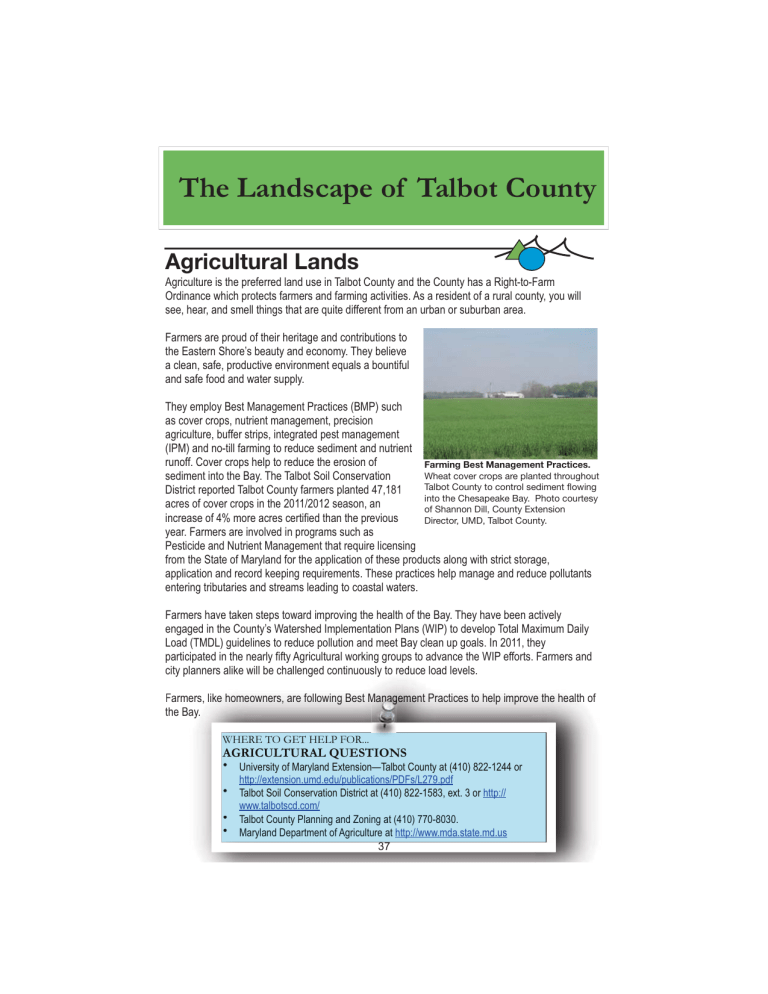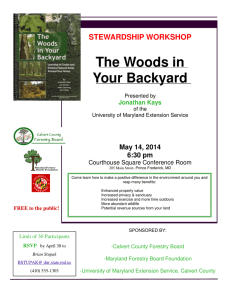Agricultural Lands

The Landscape of Talbot County
Agricultural Lands
Agriculture is the preferred land use in Talbot County and the County has a Right-to-Farm
Ordinance which protects farmers and farming activities. As a resident of a rural county, you will see, hear, and smell things that are quite different from an urban or suburban area.
Farmers are proud of their heritage and contributions to the Eastern Shore’s beauty and economy. They believe a clean, safe, productive environment equals a bountiful and safe food and water supply.
They employ Best Management Practices (BMP) such as cover crops, nutrient management, precision agriculture, buffer strips, integrated pest management
(IPM) and no-till farming to reduce sediment and nutrient runoff. Cover crops help to reduce the erosion of sediment into the Bay. The Talbot Soil Conservation
District reported Talbot County farmers planted 47,181 acres of cover crops in the 2011/2012 season, an increase of 4% more acres certified than the previous
Farming Best Management Practices.
Wheat cover crops are planted throughout
Talbot County to control sediment flowing into the Chesapeake Bay. Photo courtesy of Shannon Dill, County Extension
Director, UMD, Talbot County.
year. Farmers are involved in programs such as
Pesticide and Nutrient Management that require licensing from the State of Maryland for the application of these products along with strict storage, application and record keeping requirements. These practices help manage and reduce pollutants entering tributaries and streams leading to coastal waters.
WHERE TO GET HELP FOR...
AGRICULTURAL QUESTIONS
•
University of Maryland Extension—Talbot County at (410) 822-1244 or http://extension.umd.edu/publications/PDFs/L279.pdf
•
Talbot Soil Conservation District at (410) 822-1583, ext. 3 or http:// www.talbotscd.com/
•
Talbot County Planning and Zoning at (410) 770-8030.
•
Maryland Department of Agriculture at http://www.mda.state.md.us
37
From My Backyard to Our Bay
Wetlands
Maryland’s Eastern Shore is located on the Outer Coastal Plain which is characterized by flat land with low elevation. The
Coastal Plain is 54% of
Salt Marsh. Typical salt marsh on
Maryland’s Eastern Shore. Photo courtesy of Environmental Concern Inc.
Maryland’s land surface but contains 94% of the
State’s wetlands.
Approximately 16% of the land surface on the
Eastern Shore are wetlands; 12% of land
Wildlife. Great Egrets and other shore birds often visit salt marshes. Photo courtesy of Environmental
Concern Inc.
surface in Talbot County are wetlands. As residents of Talbot County we have the opportunity to experience the beauty of wetlands around us every day.
Wetlands are amazing places. They are critically important to the health of the Bay. They filter pollutants and sediment, produce oxygen, absorb pollutants and nutrients from runoff and tidal waters. They have the ability to take vast amounts of carbon from the atmosphere and store it in plant material both above and below ground. Wetland soils support a process called denitrification, by which excess nitrogen from fertilizers and animal waste are converted to a harmless gas and released to the atmosphere.
Wetland plants form the base of the food chain for marine and other wildlife. Chesapeake Bay fisheries rely on tidal wetlands which provide habitat for 97% of commercially important fish species during part of their life. Wetlands make available nesting and breeding grounds for many bird species, and overwintering areas and
Tidal Wetlands. Horseshoe crabs mate along tidal wetland near the Tred Avon
River, Easton, Maryland.
feeding grounds for migratory waterfowl.
Wetlands serve as habitat for blue crabs, and nesting habitat for
Maryland’s State
Reptile.
backed terrapin basking in the mud of a tidal wetland.
Tidal wetlands serve yet another important role related to shorelines.
They support plant life and structure that protect the shorelines from from wave energy and erosion.
38
The Landscape of Talbot County
Nontidal wetlands including forested wetlands, streams, and ponds help prevent flooding by absorbing excess rainwater. They recharge groundwater and our drinking water aquifers. They provide critical habitat for amphibians and other wildlife.
Wetlands need protection. It is estimated that
Maryland has lost over 60% of its wetlands to draining or filling for agricultural uses and development. On the Eastern Shore many acres of forested wetlands were cleared and drained to grow crops, and many miles of tidal wetlands along shorelines have been altered to construct our homes and towns. Sea level rise threatens the
Oxford Wetland. Sign indicating protected wetland area at park in Oxford, Maryland.
destruction of still more. Changes in the landscape can alter the flow of water to a wetland, isolate it from other nearby wetlands, result in a wetland filling with sediment, organized Herp Atlas outing at Seth State Forest
WHERE TO GET HELP FOR...
WETLANDS
•
Maryland Department of the Environment at http://www.mde.state.md.us/ programs/Water/WetlandsandWaterways/DocumentsandInformation/
•
Pages/Programs/WaterPrograms/Wetlands_Waterways/ documents_information/mdwetlands.aspx#coastal
Environmental Concern at (410) 745-9620 or www.wetland.org
, or http:// www.wetland.org/restoration_visit_Waterside.htm
From My Backyard to Our Bay
Forest Stewardship
Forestland is important to the overall health of the Chesapeake Bay. Forests provide several layers, from the canopy to the forest floor, that act as filters, improve water quality, reduce sedimentation, remove nutrients, and regulate stream flow during storms.
Maryland’s 2.5 million acres of forest, most of it privately owned, cover approximately
42% of its land area. In comparison, about
24% of Talbot County is forestland, reflecting the County’s intensive agricultural use. With Talbot County’s location adjacent to the upper Chesapeake
Bay and its tributaries, its forests—and particularly its forested buffers—are critical to improving Bay health. The County occupies a forest transitional zone, where the dominant tree species vary from oak/ hickory to tulip poplar to sweet gum/red maple and loblolly pine.
Naturally Forested Area. Forest floors function as sponges, absorbing runoff, allowing water to recharge underground supplies.
Forests can be harvested on a sustainable basis for materials, including structural lumber, crates, shelving and furniture, flooring, mulch, and pulp for paper. If managed properly they can provide these products while also maintaining and even enhancing wildlife habitat, recreational activities, and soil conservation benefits. Timber harvests are closely monitored by a partnership of agencies, including
Talbot Soil Conservation District and Talbot County Planning and Zoning. For harvests occurring within the 1,000-foot Critical Area, the Talbot County Forestry Board also provides a t t h e
WHERE TO GET HELP FOR...
FOREST STEWARDSHIP QUESTIONS
•
Maryland DNR – Forest Service Upper Shore Project at (410) 819-4120.
•
Maryland Department of Natural Resources at www.dnr.maryland.gov
•
Talbot Soil Conservation District at (410) 822-1583, ext. 3.
•
Talbot County Planning and Zoning at (410) 770-8030.
•
National Agroforestry Center at www.unl.edu/nac
40
Talbot County Master Gardener Program
Maryland Master Gardener Vision: A healthier world through environmental stewardship.
Talbot County Master Gardener’s Mission: To support the University of Maryland Extension
Vision by educating Talbot County residents about safe, effective and sustainable horticultural practices that build healthy gardens, landscapes, Chesapeake Bay tributaries and communities.
Background: The Maryland Master Gardener Program was started in 1978 as a means of extending the horticultural and pest management expertise of University of Maryland Extension
(UME) to the general public. Today, this popular program can be found in 18 Maryland counties,
Baltimore City, and two Maryland prisons.
The program is designed to train volunteer horticultural educators for UME—the principal outreach education unit of the University of Maryland. Participants receive 40-50 hours of basic training from University of Maryland professionals and then agree to work in their communities to teach Marylanders how to cultivate garden spaces and manage landscapes sustainably using research-based information. This environmental horticulture approach reduces fertilizer and pesticide use resulting in improved soil and water quality.
Bay-Wise Certification: One of the most active
Master Gardener programs is Bay-Wise. Once
Master Gardeners participating in this program receive additional training, they are Bay-Wise certified. Any Talbot County homeowner can request a consultation at his or her home by a team of Bay-
Wise volunteers by contacting the Extension Office.
Two to three Bay-Wise MGs will then visit the property with the homeowner to determine areas of concern, answer open questions, and make Bay-
Wise recommendations. Once the homeowner addresses suggested changes to incorporate Bay-
Bay-Wise Certification Signage. A homeowner receives this a Bay-Wise sign when his/her landscape is certified Bay-Wise.
Wise best practices, the Bay-Wise MGs return for certification. A landscape meeting multiple best-practice guidelines becomes Bay-Wise certified, and receives a Bay-Wise certification sign.
For more information on a Bay-Wise consultation for your home, call the University of Maryland
Extension — Talbot County at (410) 822-1244 or the Home and Garden Information Center at
(410) 531-5556 or (800) 342-2507.
University of Maryland Extension programs are open to all citizens without regard to race, color, gender, disability, religion, age, sexual orientation, marital or parental status, or national origin.
41
Partners & Contributors
Funding and development for this project were provided by:
University of Maryland Extension
Talbot County
(410) 822-1244 www.talbot.umd.edu
www.mastergardener.umd.edu
Agencies of the Talbot County Government
Easton, Maryland 21610 www.talbotcountymd.gov
Office of Environmental Health
215 Bay Street, Suite 4
(410) 770-6880
Department of Public Works
215 Bay Street, Suite 6
(410) 770-8170
Planning and Zoning
215 Bay Street, Suite 2
(410) 770-8030
Weed Control
(410) 770-8157
Talbot Soil Conservation District
(410) 822-1583, ext. 3 www.talbotscd.com
Choptank Tributary Team www.choptanktribteam.net
Maryland Department of Natural Resources
Chesapeake & Atlantic Coastal Bays Trust Fund
www.dnr.maryland.gov
42
Partners & Contributors
Special thanks for contributions by:
Environmental Concern Inc.
(410) 745-9620 www.wetland.org
Midshore Recycling
(410) 758-6605 www.midshorerecycling.org
Midshore Riverkeeper Conservancy
(443) 385-0511 www.midshoreriverkeeper.org
Hill’s Drug Stores
(410) 819-6541 http://www.hillsdrugstore.com
Sylvan Green Earth www.SylvanGreenEarth.com
Additional Credits
Most photos are credited in each photo caption. The following provides credit for those photos not referenced: Cover photo (bottom) contributed by Diane Miller, Choptank Tributary Team member and
Restoration Specialist, Environmental Concern Inc. Cover photo (top) and on pages 9 (bottom), 10
11, 12 (left),13, 16, 21 (left), 22 (top), 25, 32, 33 (right), 38 (two bottom), 39 and 40 were contributed by Lisa Marie Ghezzi, Talbot County Bay-Wise certified Master Gardener. Lisa Marie Ghezzi wrote and assembled this booklet with invaluable contributions made by Diane Miller, Jennifer Dindinger,
Chris Myles-Tochko, Joan Dickson, Talbot Soil Conservation District, and Kent County Soil and
Water Conservation District. Many other Talbot County volunteers, organizations with niche expertise, and associated government entities contributed and/or vetted the contents of this booklet.
43

